Themed collection Equilibrium Solution Coordination Chemistry

Equilibrium solution coordination chemistry
Welcome to this themed issue of New Journal of Chemistry entitled “Equilibrium Solution Coordination Chemistry”.
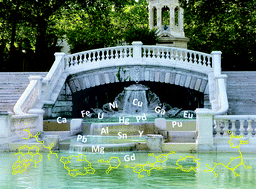
New J. Chem., 2018,42, 7514-7515
https://doi.org/10.1039/C8NJ90042F
Focus on speciation assessment in marine radiochemistry using X-ray absorption spectroscopy
We review the state-of-the-art and recent advances in the determination of radionuclide speciation in seawater.
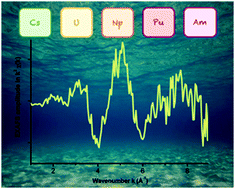
New J. Chem., 2018,42, 7582-7591
https://doi.org/10.1039/C7NJ04862A
Dynamic NMR for coordination chemistry
Kinetic information that cannot be acquired with other techniques can be obtained by carefully planned and dynamic NMR experiments.
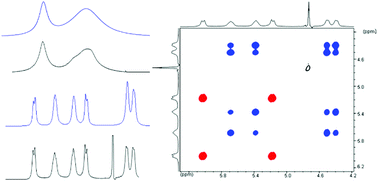
New J. Chem., 2018,42, 7569-7581
https://doi.org/10.1039/C8NJ00233A
Metal ion complexes of nucleoside phosphorothioates reflecting the ambivalent properties of lead(II)
The lead(II)-lone pair leads to ambivalency: hemidirected (distorted, non-spherical) coordination spheres result from electronegative O-coordination and holodirected (symmetric, spherical) ones from less electronegative S-coordination.
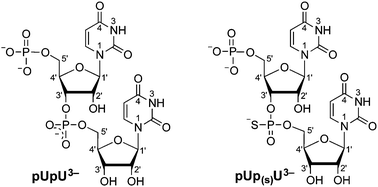
New J. Chem., 2018,42, 7551-7559
https://doi.org/10.1039/C7NJ04989G
Antimicrobial peptide–metal ion interactions – a potential way of activity enhancement
We discuss the potential correlation between the antimicrobial peptide–metal binding mode, structure, thermodynamics and mode of action.
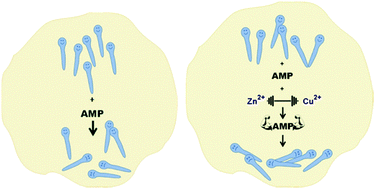
New J. Chem., 2018,42, 7560-7568
https://doi.org/10.1039/C7NJ04709F
Porphyrins in troubled times: a spotlight on porphyrins and their metal complexes for explosives testing and CBRN defense
A critical perspective on (metallo)porphyrins in security-related applications: the past, present and future of explosives detection, CBRN defense, and beyond.
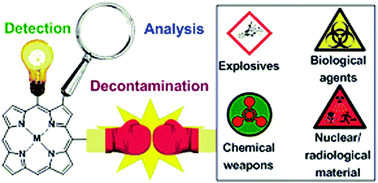
New J. Chem., 2018,42, 7529-7550
https://doi.org/10.1039/C7NJ04679K
Speciation and reactivity of heptavalent technetium in strong acids
The speciation of Tc(VII) and its reactivity with H2O2, methanol and H2S in H2SO4, HClO4 and HNO3 is reviewed.
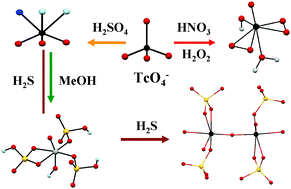
New J. Chem., 2018,42, 7522-7528
https://doi.org/10.1039/C7NJ04912A
Stabilization of synthetic heme-superoxo complexes by hydrogen bonding: a still on-going quest
The design of various types of synthetic heme models has allowed the fine tuning of the location of hydrogen bond donors around the ferrous coordination site. Through the years, it has migrated from a lateral to a quasi-apical position. Still, the unambiguous existence of an actual H-bond with the dioxygen adduct remains to be established.
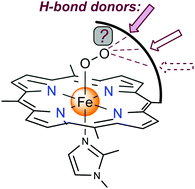
New J. Chem., 2018,42, 7516-7521
https://doi.org/10.1039/C7NJ04145D
Self-locked dipillar[5]arene-based pseudo[1]rotaxanes and bispseudo[1]rotaxanes with different lengths of bridging chains
The relationships between lengths of bridging chains and self-locked behaviors of dipillar[5]arene-based pseudo[1]rotaxanes and bispseudo[1]rotaxanes were studied in detail.
![Graphical abstract: Self-locked dipillar[5]arene-based pseudo[1]rotaxanes and bispseudo[1]rotaxanes with different lengths of bridging chains](/en/Image/Get?imageInfo.ImageType=GA&imageInfo.ImageIdentifier.ManuscriptID=C7NJ05192A&imageInfo.ImageIdentifier.Year=2018)
New J. Chem., 2018,42, 7603-7606
https://doi.org/10.1039/C7NJ05192A
Assessment of the ground spin state of iron(I) complexes: insights from DFT predictive models
Factors governing the ground spin state of iron(I) complexes are analyzed by DFT methods. An efficient benchmarking procedure is reported.
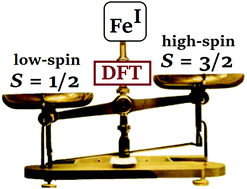
New J. Chem., 2018,42, 7612-7616
https://doi.org/10.1039/C7NJ04816E
Grafted monolayers of the neutral Cu(II) complex of a dioxo-2,3,2 ligand: surfaces with decreased antibacterial action
A monolayer of the neutral Cu2+ complex of a silane-bearing diamino–diamido ligand is formed on glass, exhibiting (decreased) antibacterial properties.
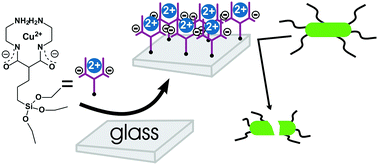
New J. Chem., 2018,42, 7595-7598
https://doi.org/10.1039/C7NJ04601D
Synthesis of flexible nanotweezers with various metals and their application in carbon nanotube extraction
Flexible nanotweezers including Co(II) dispersed single-walled carbon nanotubes in methanol.
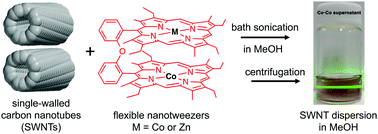
New J. Chem., 2018,42, 7592-7594
https://doi.org/10.1039/C8NJ00147B
Complexes of guest–host type between C60 and group 9 metalloporphyrins
Half-sandwich iridium(III) and cobalt(III) porphyrin-C60 co-crystals, C60·IrIII(ttp)Ph and C60·CoIII(ttp)Ph/C7H8, and triangular-sandwich C60·3IrIII(ttp)Ph, where ttp = tetra-p-tolylporphyrinato dianion, were synthesized.
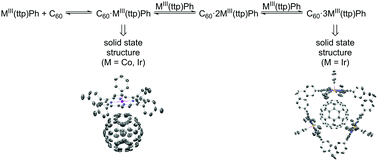
New J. Chem., 2018,42, 7599-7602
https://doi.org/10.1039/C7NJ05081J
A camphor based 1,3-diamine Ru(II) terpyridine complex: synthesis, characterization, kinetic investigation and DNA binding
A chiral ancillary ligand that has more steric bulk results in an increased reactivity of a ruthenium complex with biomolecules.

New J. Chem., 2018,42, 7607-7611
https://doi.org/10.1039/C7NJ04674J
Exploring the chelating capacity of 2-hydroxyphenyl-benzimidazole based hybrids with multi-target ability as anti-Alzheimer's agents
Donepezil and tacrine hybrids, containing a 2-hydroxyphenyl-benzimidazole chelating moiety and with multifunctional anti-AD activity, are evaluated in terms of metal (Cu and Zn) chelating capacity.
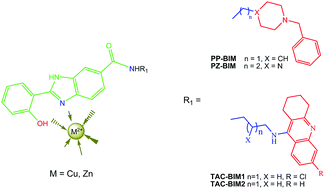
New J. Chem., 2018,42, 16503-16515
https://doi.org/10.1039/C8NJ00117K
Design, physico-chemical and pre-clinical evaluation of a homo-bivalent 99mTc-(BTZ)2DTPA radioligand for targeting dimeric 5-HT1A/5-HT7 receptors
A 99mTc-labelled bis-benzothiazolone-DTPA radio-complex as a SPECT neuroimaging agent.
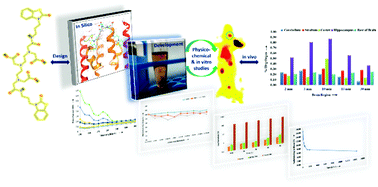
New J. Chem., 2018,42, 15032-15043
https://doi.org/10.1039/C8NJ00089A
Development of a sensor for trivalent iron: AHP fixed on mesoporous silica
Optical sensor for iron(III) detection via Fe(III) complexation in the solid phase.
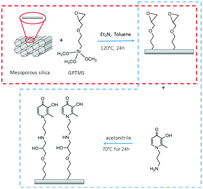
New J. Chem., 2018,42, 15237-15244
https://doi.org/10.1039/C8NJ00869H
Dicarboxylato platinum(II) complexes containing dimethyl sulfoxide and triazolopyrimidine as potential anticancer agents: synthesis, structural and biological studies in solution
N,O,S-donors platinum(II) complexes were synthesized and well characterized. We demonstrate that modification of coordination sphere by insertion of dmso molecule and bulky triazolopyrimidine ligand is good direction for the design effective less toxic platinum(II) complexes.
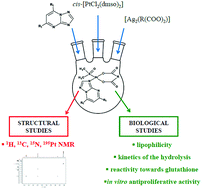
New J. Chem., 2018,42, 8113-8122
https://doi.org/10.1039/C8NJ01199K
Binding of aluminium/cacodylate complexes with DNA and RNA. Experimental and “in silico”study
Mechanism of the interaction of a dinuclear aluminium/cacodylate complex with nucleic acids.
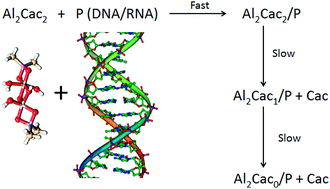
New J. Chem., 2018,42, 8137-8144
https://doi.org/10.1039/C8NJ01779D
Triorganotin(IV) cation-promoted dimethyl carbonate synthesis from CO2 and methanol: solution and solid-state characterization of an unexpected diorganotin(IV)-oxo cluster
Novel C,N-chelated organotin(IV) complexes bearing weakly coordinating carborane moieties were prepared and used as a catalyst precursor for the direct synthesis of dimethyl carbonate (DMC) from CO2 and methanol.

New J. Chem., 2018,42, 8253-8260
https://doi.org/10.1039/C7NJ05058E
Ligand and electronic effects on copper–arylnitroso self-assembly
The topology and degree of electron transfer in self-assembled redox reactions between copper(I) species and nitrosoarenes are controlled by ligand properties.
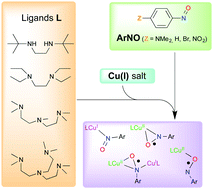
New J. Chem., 2018,42, 7758-7764
https://doi.org/10.1039/C8NJ00894A
J-Aggregation induced emission enhancement of a thienyl substituted bis(difluoroboron)-1,2-bis((1H-pyrrol-2-yl)methylene)hydrazine (BOPHY) dye
The synthesis and characterization of 2,7-diphenyl- and 2,7-dithienyl-1,3,6,8-tetramethyl bis(difluoroboron)-1,2-bis((1H-pyrrol-2-yl)methylene)hydrazine (BOPHY) derivatives 1 and 2 are described.
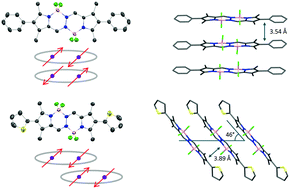
New J. Chem., 2018,42, 8271-8275
https://doi.org/10.1039/C8NJ00031J
ESIPT-capable 2,6-di(1H-imidazol-2-yl)phenols with very strong fluorescent sensing signals towards Cr(III), Zn(II), and Cd(II): molecular variation effects on turn-on efficiency
The derivatization influence was studied for twelve 2,6-di(1H-imidazol-2-yl)phenols, whereby a strong fluorescent sensitivity for Cr(III) was reported, while Zn(II)/Cd(II) sensing potentials also appeared.
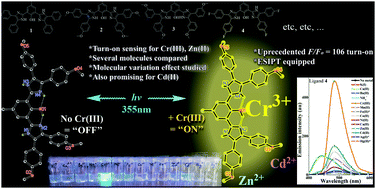
New J. Chem., 2018,42, 7884-7900
https://doi.org/10.1039/C8NJ01265B
Thermodynamic study on 8-hydroxyquinoline-2-carboxylic acid as a chelating agent for iron found in the gut of Noctuid larvae
8-HQA is a good sequestering agent towards Fe2+ and Fe3+ over a wide pH range.
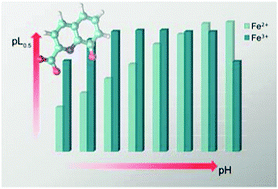
New J. Chem., 2018,42, 8062-8073
https://doi.org/10.1039/C7NJ04889K
A pyridyl-benzimidazole based molecular luminescent turnstile
A molecular turnstile based on a luminescent pyridyl-benzimidazole stator and a rotor containing a pyridyl coordinating site may be reversibily switched between its open and closed states upon binding/unbinding of silver cations.
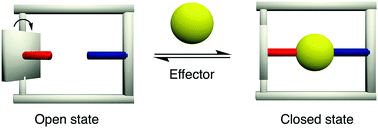
New J. Chem., 2018,42, 7810-7815
https://doi.org/10.1039/C8NJ00890F
Synthesis and structural, photophysical, electrochemical redox and axial ligation properties of highly electron deficient perchlorometalloporphyrins and selective CN− sensing by Co(II) complexes
Synthesis and characterization of MTPP(NO2)Cl7 have been reported. ZnII porphyrins exhibited higher Lewis acidity as compared to perbromoporphyrins. CoII porphyrins were utilized for the selective rapid visual detection of cyanide ions.
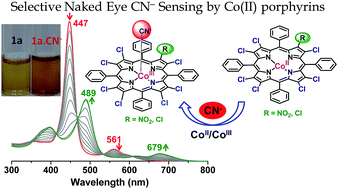
New J. Chem., 2018,42, 8190-8199
https://doi.org/10.1039/C7NJ04418F
Molecular brakes based on the Zn(II) porphyrin dimer
The rotational movement of molecular brakes based on two Zn–porphyrin units interconnected by a spacer may be reversibly locked by addition of an external auxiliary ligand.
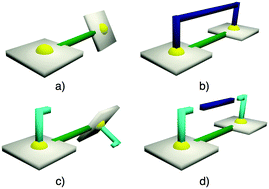
New J. Chem., 2018,42, 7816-7822
https://doi.org/10.1039/C8NJ01219A
Aminobisphosphonates based on cyclohexane backbone as coordinating agents for metal ions. Thermodynamic, spectroscopic and biological studies
Complex formation equilibria of calcium, magnesium, copper and nickel with amino-bisphosphonic ligands are described, together with a speciation study along with calorimetric outcome and cytotoxicity characteristics.
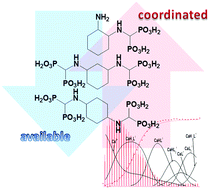
New J. Chem., 2018,42, 7723-7736
https://doi.org/10.1039/C8NJ01158C
The crucial role of the inter-ring hydrogen bond to explain the properties of morin
The acid-base properties of morin and its complexation with the ZnII cation are investigated by experimental and theoretical approaches.
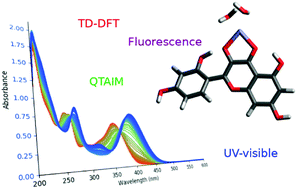
New J. Chem., 2018,42, 7691-7702
https://doi.org/10.1039/C7NJ04579D
Development of a new diffusive gradient in the thin film (DGT) method for the simultaneous measurement of CH3Hg+ and Hg2+
This technique has a high DGT capacity, wide tolerance of pH and ionic strength and good performance as an in situ monitoring tool.
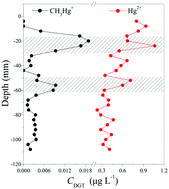
New J. Chem., 2018,42, 7976-7983
https://doi.org/10.1039/C8NJ00211H
A new tripodal-3-hydroxy-4-pyridinone for iron and aluminium sequestration: synthesis, complexation and in vivo studies
A new highly efficient tris-hydroxypyridinone chelator for iron and aluminum, with promising capacity as a potential metal decorporation agent.
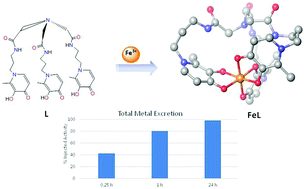
New J. Chem., 2018,42, 8050-8061
https://doi.org/10.1039/C8NJ00116B
Complexes of phosphonate and phosphinate derivatives of dipicolylamine
Phospho(i)nate derivatives of dipicolylamine show excellent selectivity for Zn(II) over alkaline earth metal ions.
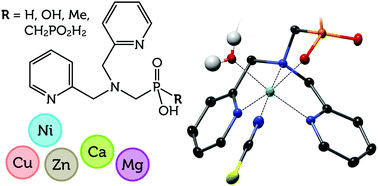
New J. Chem., 2018,42, 7713-7722
https://doi.org/10.1039/C8NJ00100F
Selective coordination of cyanate and thiocyanate in the end-on mode: synthesis, structures and properties of [NiII2L(μ1,1-NCO)]+ and [NiII2L(μ1,1-NCS)]+ (L2− = macrocyclic N6S2 ligand)
The complex [Ni2L]2+ exhibits a pre-organized binding pocket, whose walls direct the coordination of pseudohalide ions via repulsive CH⋯π interactions.
![Graphical abstract: Selective coordination of cyanate and thiocyanate in the end-on mode: synthesis, structures and properties of [NiII2L(μ1,1-NCO)]+ and [NiII2L(μ1,1-NCS)]+ (L2− = macrocyclic N6S2 ligand)](/en/Image/Get?imageInfo.ImageType=GA&imageInfo.ImageIdentifier.ManuscriptID=C8NJ00114F&imageInfo.ImageIdentifier.Year=2018)
New J. Chem., 2018,42, 7630-7639
https://doi.org/10.1039/C8NJ00114F
Combined HPLC-ICP-AES technique as an informative tool for the study of heteropolyniobates
This paper summarizes the application of the coupled HPLC-ICP-AES technique to study the substitution of niobium by tungsten in [Nb6O19]8− or [(OH)TeNb5O18]6− Lindqvist anions and the screening of mixed [PMo12−xNbxO40]n− Keggin anion formation.
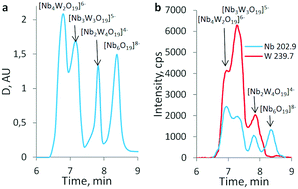
New J. Chem., 2018,42, 7949-7955
https://doi.org/10.1039/C7NJ03917D
Iron(III) coordination properties of ladanein, a flavone lead with a broad-spectrum antiviral activity
The Fe(III) complexation properties of ladanein, a potent antiviral flavone, and related analogues (negletein and salvigenin), have been studied in solution under quasi-physiological conditions using physico-chemical tools and provided important insights into their stability/reactivity in solution.
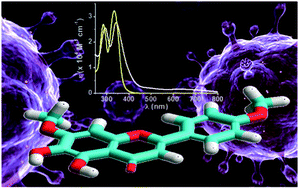
New J. Chem., 2018,42, 8074-8087
https://doi.org/10.1039/C7NJ04867J
Non-symmetrical bis(aminoalkyl)phosphinates: new ligands with enhanced binding of Cu(II) ions
Novel, non-symmetrical bis(aminoalkyl)phosphinic acids exhibit enhanced efficiency in Cu(II) ion binding.
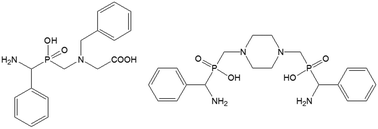
New J. Chem., 2018,42, 7737-7745
https://doi.org/10.1039/C8NJ01094C
Unusual PLS application for Pd(II) sensing in extremely acidic solutions
Tazoc-Mar@: a simple device that turns into a deep blue colour in presence of Pd(II) at very low concentration.
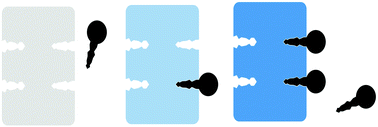
New J. Chem., 2018,42, 7901-7907
https://doi.org/10.1039/C7NJ05085B
para-Aminosalicylic acid in the treatment of manganese toxicity. Complexation of Mn2+ with 4-amino-2-hydroxybenzoic acid and its N-acetylated metabolite
Manganese excess can induce in humans neurological disorders known as manganism.
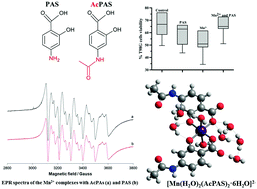
New J. Chem., 2018,42, 8035-8049
https://doi.org/10.1039/C7NJ04648K
Ln(III) complexes with triptycene based tripodal ligands: speciation and equilibria
The speciation studies of Ln(III) complexes with triptycene-based tripodal ligands reveal slow transformations of tetranuclear assemblies in metal excess.
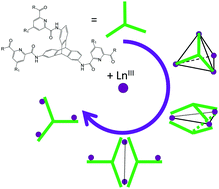
New J. Chem., 2018,42, 7803-7809
https://doi.org/10.1039/C8NJ00252E
Half-sandwich type rhodium(III)–aminohydroxamate complexes: the role of the position of the amino group in metal ion binding
Relative order of the pH-dependent conditional stability of the hydroxamate type (O,O) and (Namino,Nhydroxamato) chelates determines the coordination modes in the various mono- and dinuclear complexes of [(η5-Cp*)RhIII(H2O)3]2+ with α-, β- and γ-aminohydroxamic acids.

New J. Chem., 2018,42, 7659-7670
https://doi.org/10.1039/C7NJ04711H
CdII/ZnII discrimination using 2,5-diphenyl[1,3,4]oxadiazole based fluorescent chemosensors
Two ditopic PPD based ligands are able to discriminate CdII over ZnII in aqueous solution based on the difference in their ionic radii, acting as OFF–ON fluorescent probes.
![Graphical abstract: CdII/ZnII discrimination using 2,5-diphenyl[1,3,4]oxadiazole based fluorescent chemosensors](/en/Image/Get?imageInfo.ImageType=GA&imageInfo.ImageIdentifier.ManuscriptID=C8NJ00113H&imageInfo.ImageIdentifier.Year=2018)
New J. Chem., 2018,42, 7869-7883
https://doi.org/10.1039/C8NJ00113H
Mono-DMSO ligated cobalt nitrophenylcorroles: electrochemical and spectral characterization
Four mono-DMSO ligated cobalt corroles with one or three meso-nitrophenyl substituents on the macrocycle were synthesized and investigated as to their electrochemical and spectroscopic properties in CH2Cl2 and DMSO.
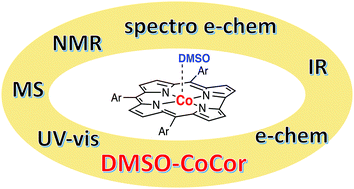
New J. Chem., 2018,42, 8220-8229
https://doi.org/10.1039/C8NJ00300A
FRET-based metal ion sensing by a crown-containing bisstyryl dye
A ratiometric cation FRET system containing two binding centers demonstrates distinct fluorescence changes upon interaction with alkaline, alkaline earth and heavy metal cations.
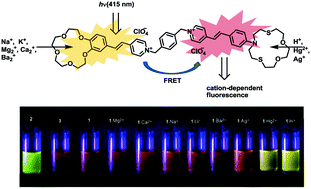
New J. Chem., 2018,42, 7908-7913
https://doi.org/10.1039/C8NJ00205C
Taking the next step toward inert Mn2+ complexes of open-chain ligands: the case of the rigid PhDTA ligand
Equilibrium, dissociation kinetics, relaxometric and electrochemical properties of the [Mn(PhDTA)]2− complex were investigated and the structure of the [Mn(PhDTA)]2− complex was studied by using DFT calculations.
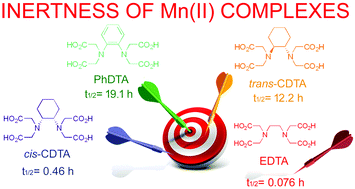
New J. Chem., 2018,42, 8001-8011
https://doi.org/10.1039/C8NJ00121A
Mn2+ complexes of open-chain ligands with a pyridine backbone: less donor atoms lead to higher kinetic inertness
The loss of a coordinating donor atom in the ligand leads to lower thermodynamic stability, but higher kinetic inertness of Mn2+ complexes.
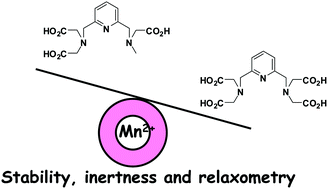
New J. Chem., 2018,42, 8012-8020
https://doi.org/10.1039/C8NJ00648B
Moving corrole towards a red-record: synthesis of β-acrolein Ga and Cu corroles using the Vilsmeier reaction
Pioneering the red region of emission! β-acrolein substituted Ga corroles show the longest fluorescence emission reported for monomeric corroles.
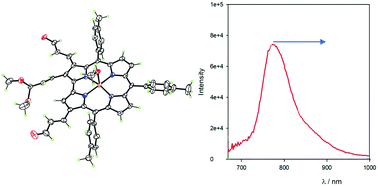
New J. Chem., 2018,42, 8200-8206
https://doi.org/10.1039/C7NJ04705C
New curcumin-derived ligands and their affinity towards Ga3+, Fe3+ and Cu2+: spectroscopic studies on complex formation and stability in solution
Chemico-physical properties, metal chelating ability, antiproliferative activity and DNA binding of new curcuminoids with improved stability.
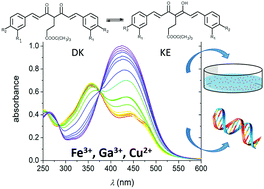
New J. Chem., 2018,42, 7680-7690
https://doi.org/10.1039/C8NJ00535D
The time-resolved fluorescence study of kinetics and thermodynamics of Eu(III) and Tb(III) complexes with the DO2A macrocyclic ligand
The thermodynamics and kinetics of formation/dissociation of Eu(III) and Tb(III) with the H2DO2A macrocyclic ligand were studied by time-resolved fluorescence spectroscopy.

New J. Chem., 2018,42, 7993-8000
https://doi.org/10.1039/C8NJ00255J
Syntheses of 1,2,3-triazole-BODIPYs bearing up to three carbohydrate units
BODIPYs bearing up to three glucose units were synthesized and their cytotoxicity and uptake investigated in human HEp2 cells.
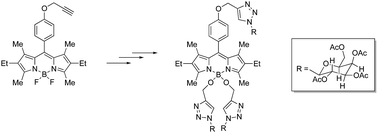
New J. Chem., 2018,42, 8241-8246
https://doi.org/10.1039/C8NJ00041G
How zinc ions shift and enhance the nucleotide's fluorescence spectra
Zinc–nucleotide complexes in alkaline solutions exhibit strong fluorescence enhancement and red shift, thus enabling an optical discrimination between the nucleotides.
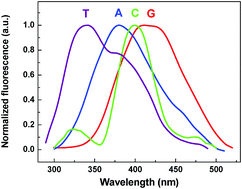
New J. Chem., 2018,42, 8145-8150
https://doi.org/10.1039/C7NJ04630H
A HPLC-ICP-AES technique for the screening of [XW11NbO40]n− aqueous solutions
In this research combined HPLC-ICP-AES technique was used to study formation of mixed [XW11O40]n− (X = P, Ge, B) complexes.
![Graphical abstract: A HPLC-ICP-AES technique for the screening of [XW11NbO40]n− aqueous solutions](/en/Image/Get?imageInfo.ImageType=GA&imageInfo.ImageIdentifier.ManuscriptID=C7NJ04702A&imageInfo.ImageIdentifier.Year=2018)
New J. Chem., 2018,42, 7940-7948
https://doi.org/10.1039/C7NJ04702A
1D Co(II) coordination polymers based on cyclobutyl- and cyclopentyl-substituted zoledronate analogues: synthesis, structural comparison, thermal stability and magnetic properties
Competing magnetic exchange in 1a and 2a with predominant participation of antiferromagnetic interactions in 1a and ferromagnetic exchange in 2a.
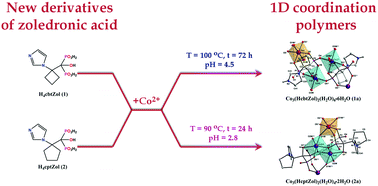
New J. Chem., 2018,42, 7830-7844
https://doi.org/10.1039/C8NJ00118A
Investigation on the metal binding sites of a putative Zn(II) transporter in opportunistic yeast species Candida albicans
The protein fragment C4YJH2 of Candida albicans has the ability to tightly coordinate Zn(II) at its C-terminal region by means of an evolutionarily well-conserved histidine-rich sequence.
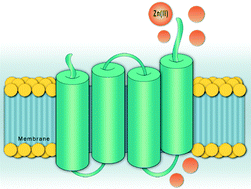
New J. Chem., 2018,42, 8123-8130
https://doi.org/10.1039/C8NJ00533H
A glassy carbon electrode modified by a triply-fused-like Co(II) polyporphine and its ability for sulphite oxidation and detection
An original Co(II) porphyrin conductive polymer is electrosynthesized which efficiently catalyzes sulphite oxidation in water offering opportunities for sensor development.
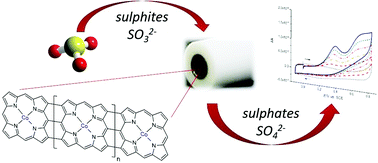
New J. Chem., 2018,42, 8180-8189
https://doi.org/10.1039/C7NJ04370H
Late transition metal recovery from a silver nitrate electrolyte using a phosphine-oxide bearing scavenger
A method to recover Pd and Pt from a silver nitrate electrolyte was developed.
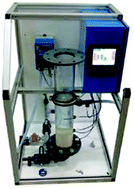
New J. Chem., 2018,42, 7969-7975
https://doi.org/10.1039/C7NJ04928E
Effects of preorganization in the chelation of UO22+ by hydroxamate ligands: cyclic PIPO−vs. linear NMA−
Thanks to preorganization, 1,2-PIPOH, the six-membered ring cyclic hydroxamic acid, binds uranyl six times more strongly than its linear, methyl-substituted homolog (NMAH).
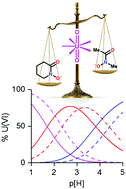
New J. Chem., 2018,42, 7765-7779
https://doi.org/10.1039/C8NJ00166A
Regioselective addition of DDQ on a quinoid ring: an entry into chiral zwitterionic bridging ligands
The Michael-type addition of DDQ on a zwitterionic ligand is described together with the chiral separation and full characterization of the two enantiomers of one derivative. These adducts offer a novel entry into chiral zwitterionic quinoidal ligands.
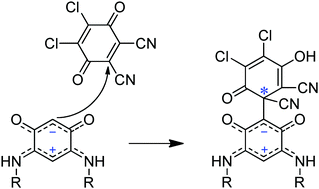
New J. Chem., 2018,42, 8247-8252
https://doi.org/10.1039/C7NJ03765A
Aurophilicity vs. thiophilicity: directing the crystalline supramolecular arrangement in luminescent gold compounds
The fluorination of thiolate ligands is applied as a tool that allows control of the prevalence of thiophilic (Au–S) interactions over the expected aurophilic contacts in luminescent gold compounds.
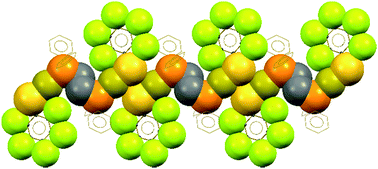
New J. Chem., 2018,42, 7845-7852
https://doi.org/10.1039/C7NJ04354F
The complexation and thermodynamics of neptunium(V) with acetate in aqueous solution
The complexation of NpO2+ with acetate is studied in aqueous solution by absorption spectroscopy as a function of the total ligand concentration (NaAc), ionic strength (Im = 0.5–4.0 mol kg−1 Na+(Cl−/ClO4−)) and temperature (T = 20–85 °C).
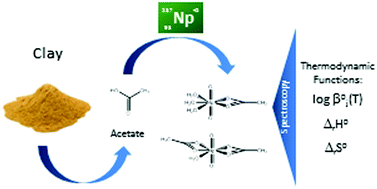
New J. Chem., 2018,42, 7796-7802
https://doi.org/10.1039/C7NJ04916A
Complexation of protactinium(V) with nitrilotriacetic acid: a study at the tracer scale
Complexation of Pa(V) with nitrilotriacetic acid (NTA) in aqueous solution (1 M (Na,H)ClO4) was studied by solvent extraction at different acidities (pcH = 0.6; 1.0; 2.0 and 2.5) with the element at the tracer scale (CPa < 10−10 M).
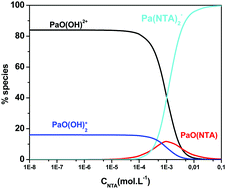
New J. Chem., 2018,42, 7789-7795
https://doi.org/10.1039/C7NJ04683A
Synthesis and coordination studies of 5-(4′-carboxyphenyl)-10,15,20-tris(pentafluorophenyl)porphyrin and its pyrrolidine-fused chlorin derivative
An efficient strategy was developed to obtain carboxyphenyl porphyrin, chlorins and metal complexes, with potential applications in photonics and biology.
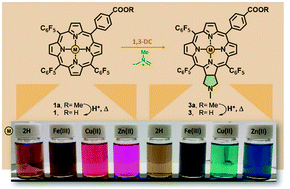
New J. Chem., 2018,42, 8169-8179
https://doi.org/10.1039/C7NJ05165D
Impact of Cu(II) and Zn(II) ions on the functional properties of new PAMAM metallodendrimers
Two new PAMAM metallodendrimers have been synthesized and characterized and their antimicrobial activity in solution and after deposition on textile fabrics has been described.
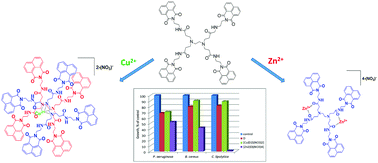
New J. Chem., 2018,42, 7853-7862
https://doi.org/10.1039/C8NJ00384J
Complex formation of nickel(II) and zinc(II) ions with peptide fragments of rat amylin
For nickel(II)-SSNX-NH2 an equilibrium between the common (NH2,3N−(peptide)) and (NH2,2N−(peptide),N−(asparagine)) coordination modes was observed in a basic solution resulting in an increased stability of the complexes.
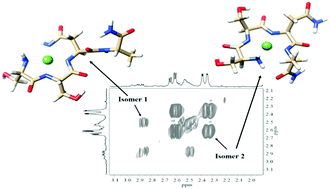
New J. Chem., 2018,42, 8131-8136
https://doi.org/10.1039/C7NJ04605G
pH-Induced fragmentation of colloids based on responsive self-assembled copper(II) metallopolymers
Responsive colloids made from copper(II) coordination polymers are readily dissolved in acidic medium following a controlled depolymerization of the polymer chains.
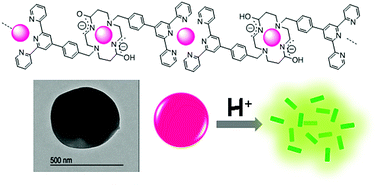
New J. Chem., 2018,42, 7823-7829
https://doi.org/10.1039/C7NJ05100J
Toxic heavy metal – Pb, Cd, Sn – complexation by the octadentate hydroxypyridinonate ligand archetype 3,4,3-LI(1,2-HOPO)
The toxicity of heavy metals such as lead (Pb), cadmium (Cd) and tin (Sn) has long been known but accidental exposures of large populations to these elements remain unfortunately a topical issue.
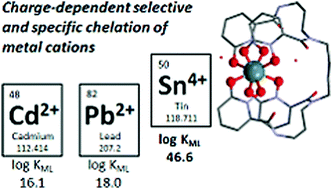
New J. Chem., 2018,42, 7649-7658
https://doi.org/10.1039/C7NJ04559J
Iron, iron everywhere: synthesis and characterization of iron 5,10,15-triferrocenylcorrole complexes
A new series of iron triferrocenylcorroles with three different axial ligands, NO, Cl− and σ-Ph, is synthesized and characterized using 1H NMR, electrochemical and spectroelectrochemical techniques in nonaqueous media.
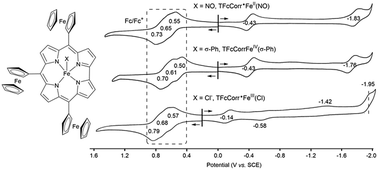
New J. Chem., 2018,42, 8207-8219
https://doi.org/10.1039/C7NJ05076C
EPR and 51V NMR studies of prospective anti-diabetic bis(3-hydroxy-4-pyridinonato)oxidovanadium(IV) complexes in aqueous solution and liposome suspensions
EPR/51V-NMR parallel studies of [VO(3,4-HPO)2] complexes in MOPS buffer and POPC liposome suspensions provide information regarding solvents for oral administration.
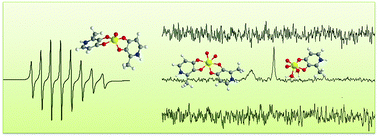
New J. Chem., 2018,42, 8088-8097
https://doi.org/10.1039/C7NJ04678B
Design of two-photon absorbing fluorophores for FRET antenna-core oxygen probes
Four two-photon absorbing fluorophores A1–A4 are reported and their spectroscopic properties are analyzed for use, in combination with palladium–porphyrinato complexes C1 and C2, as two-photon absorbing antennas and energy donors for FRET-based antenna-core oxygen sensitive phosphorescent probes.
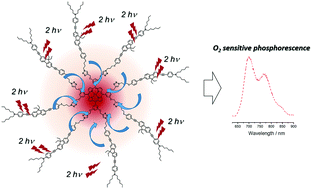
New J. Chem., 2018,42, 7914-7930
https://doi.org/10.1039/C7NJ05073A
Macrocyclic trinuclear gadolinium(III) complexes: the influence of the linker flexibility on the relaxometric properties
The flexibility/rigidity of the linker causes different relaxometric behavior in both mononuclear and trinuclear GdIII complexes based on DO3A-like structures.
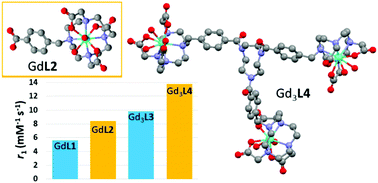
New J. Chem., 2018,42, 7984-7992
https://doi.org/10.1039/C7NJ04696K
A novel thermodynamic approach for the complexation study of toxic metal cations by a landfill leachate
The leachate humic fraction is a good sequestering agent towards toxic metal ions, influencing their aqueous solution behaviour and their environmental impact.
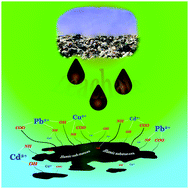
New J. Chem., 2018,42, 7640-7648
https://doi.org/10.1039/C7NJ04456A
About this collection
The New Journal of Chemistry themed issue "Equilibrium Solution Coordination Chemistry" seeks to provide a contemporary vision of thermodynamic and kinetic complexation studies and of their far-reaching relevance in analytical, biomedical, environmental, supramolecular, inorganic, physical and industrial chemistry. This collection of more than 80 contributions highlights the creativity and vitality of solution chemists with various backgrounds and centres of interest.